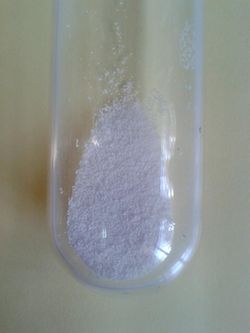Difference between revisions of "Lithium chloride"
| Line 116: | Line 116: | ||
| OtherFunction = | | OtherFunction = | ||
| OtherFunction_label = | | OtherFunction_label = | ||
| − | | OtherCompounds = [[Sodium chloride]] | + | | OtherCompounds = [[Sodium chloride]]<br>[[Potassium chloride]]<br>[[Rubidium chloride]]<br>[[Caesium chloride]] |
}} | }} | ||
}} | }} | ||
| Line 157: | Line 157: | ||
*Make lithium metal | *Make lithium metal | ||
*Make lithium compounds | *Make lithium compounds | ||
| + | *Make lithium chlorate and perchlorate via electrolysis | ||
*Make red flame | *Make red flame | ||
*Precipitate RNA from cellular extracts | *Precipitate RNA from cellular extracts | ||
Latest revision as of 21:07, 8 February 2020
 |
This article is a stub. Please help Sciencemadness Wiki by expanding it, adding pictures, and improving existing text.
|
 Anhydrous LiCl in a tube.
| |
| Names | |
|---|---|
| IUPAC name
Lithium chloride
| |
| Preferred IUPAC name
Lithium chloride | |
| Other names
Lithium(1+) chloride
Lithium monochloride | |
| Properties | |
| LiCl | |
| Molar mass | 42.39 g/mol |
| Appearance | White solid |
| Odor | Odorless |
| Density | 2.068 g/cm3 |
| Melting point | 613 °C (1,135 °F; 886 K) |
| Boiling point | 1,382 °C (2,520 °F; 1,655 K) |
| 68.29 g/100 ml (0 °C) 74.48 g/100 ml (10 °C) 84.25 g/100 ml (25 °C) 88.7 g/100 ml (40 °C) 123.44 g/100 ml (100 °C) | |
| Solubility | Soluble in acetone, butanol, diethyl ether, ethanol, hydrazine, methanol, methylformamide, nitrobenzene, propanol, pyridine, selenium oxychloride |
| Solubility in acetone | 1.2 g/100 g (20 °C) 0.83 g/100 g (25 °C) 0.61 g/100 g (50 °C) |
| Solubility in ammonia | 0.54 g/100 g (-34 °C) 3.02 g/100 g (25 °C) |
| Solubility in ethanol | 14.42 g/100 g (0 °C) 24.28 g/100 g (20 °C) 25.1 g/100 g (30 °C) 23.46 g/100 g (60 °C) |
| Solubility in formic acid | 26.6 g/100 g (18 °C) 27.5 g/100 g (25 °C) |
| Solubility in methanol | 45.2 g/100 g (0 °C) 43.8 g/100 g (20 °C) 42.36 g/100 g (25 °C) 44.6 g/100 g (60 °C) |
| Vapor pressure | 1 torr (785 °C) 10 torr (934 °C) 100 torr (1130 °C) |
| Thermochemistry | |
| Std molar
entropy (S |
59.31 J·mol-1·K-1 |
| Std enthalpy of
formation (ΔfH |
-408.27 kJ/mol |
| Hazards | |
| Safety data sheet | Sigma-Aldrich |
| Flash point | Non-flammable |
| Lethal dose or concentration (LD, LC): | |
| LD50 (Median dose)
|
526 mg/kg (rat, oral) |
| Related compounds | |
| Related compounds
|
Sodium chloride Potassium chloride Rubidium chloride Caesium chloride |
| Except where otherwise noted, data are given for materials in their standard state (at 25 °C [77 °F], 100 kPa). | |
| Infobox references | |
Lithium chloride is an ionic salt of lithium with the chemical formula LiCl.
Contents
Properties
Chemical
LiCl will react with soluble salts of heavy metals, such as silver and lead(II) nitrate, to precipitate their insoluble chlorides.
- LiCl + AgNO3 → LiNO3 + AgCl
- 2 LiCl + Pb(NO3)2 → 2 LiNO3 + PbCl2
Lithium chloride is also used as a flame colorant to produce dark red flames.
Physical
Lithium is a white hygroscopic solid compound, soluble in water and many other solvents, such as methanol, ethanol, isopropanol, butanol, formic acid, N-Methylformamide, hydrazine, THF, although it is poorly soluble in acetone and ammonia. LiCl is completely insoluble in dichloromethane. Lithium chloride has a melting point at around 614 °C.
Availability
Lithium chloride is sometimes sold as acaricid, for use against varroosis in honey bee colonies.
Lithium chloride can be purchased from chemical suppliers. ScienceCompany sells 100 g of LiCl at $18.95.
It can also be found on eBay and Amazon.
Preparation
Although lithium chloride can be prepared by reacting lithium metal with hydrochloric acid or chlorine gas, this method is both uneconomical and extremely dangerous, as it consumes the expensive metal.
- 2 Li + 2 HCl → 2 LiCl + H2
- 2 Li + Cl2 → 2 LiCl
LiCl is much better prepared by reacting lithium carbonate with HCl.
- Li2CO3 + 2 HCl → 2 LiCl + H2 + CO2
Completely dead lithium batteries are a good source of lithium carbonate. Lithium chloride can be dried to its anhydrous form by heating it in a stream of hydrogen chloride. Heating it without hydrogen chloride will cause it to partially hydrolyze.
Lithium oxide or hydroxide can also be used, but significant heat will be generated.
Projects
- Make lithium metal
- Make lithium compounds
- Make lithium chlorate and perchlorate via electrolysis
- Make red flame
- Precipitate RNA from cellular extracts
Handling
Safety
Lithium chloride affects the nervous system, so it should not be used as a salt substitute.
Storage
Lithium chloride is hygroscopic and must be stored in an airtight container (if you don't want to use its hydrated form).
Disposal
As lithium compounds can be hard to come by, they are best recycled.